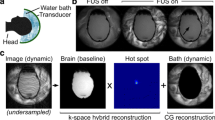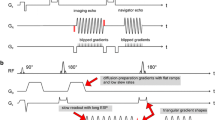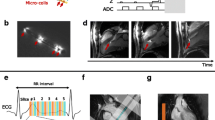Abstract
DWI thermometry is affected by CSF pulsation. To achieve more accurate determination of intraventricular temperature, we compared conventional DWI (c-DWI), acceleration motion compensation DWI (aMC-DWI), and motion compensation DWI (MC-DWI) when using two different b values (commonly used b value [1000 s/mm2] and theoretically optimized b value according to the diffusion coefficient of the CSF [400 s/mm2]). Eight healthy volunteers were scanned using a 3.0-T magnetic resonance (MR) system. The temperature map was created using the diffusion coefficient from DWI with b = 1000 and 400 s/mm2, respectively. The intraventricular temperatures in the lateral ventricles (LV) with less CSF pulsation, and the third ventricle (TV), which has more CSF pulsation, were compared between three techniques using the Friedman test. We measured the body temperature in the axilla to compare it with the intraventricular temperature. With b = 1000 s/mm2, the intraventricular temperatures in TV for c-DWI were significantly higher (43.12 ± 2.86 °C) than those for the aMC-DWI (37.68 ± 1.66 °C; P < 0.05), whereas those in LV were not significantly different (P = 0.093). With b = 400 s/mm2, the intraventricular temperatures in TV for c-DWI (75.07 ± 5.48 °C) were significantly higher than those for the aMC-DWI (38.63 ± 0.92 °C; P < 0.05), whereas those in LV were not significantly different (P = 0.093). aMC-DWI provided an intraventricular temperature that was close to or slightly higher than the body temperature in either condition. However, c-DWI- and MC-DWI-measured temperatures were higher than the body temperature, particularly in the TV. Thus, aMC-DWI can accurately determine the intraventricular temperature.



Similar content being viewed by others
References
Karaszewski B, Wardlaw JM, Marshall I, Cvoro V, Wartolowska K, Haga K, et al. Measurement of brain temperature with magnetic resonance spectroscopy in acute ischemic stroke. Ann Neurol. 2006;60:438–46.
Hasan KM, Lincoln JA, Nelson FM, Wolinsky JS, Narayana PA. Lateral ventricular cerebrospinal fluid diffusivity as a potential neuroimaging marker of brain temperature in multiple sclerosis: a hypothesis and implications. Magn Reson Imaging. 2015;33:262–9.
Rango M, Arighi A, Bonifati C, Bresolin N. Increased brain temperature in Parkinson’s disease. NeuroReport. 2012;23(3):129–33.
Rumana CS, Gopinath SP, Uzura M, Valadka AB, Robertson CS. Brain temperature exceeds systemic temperature in head-injured patients. Crit Care Med. 1998;26:562–7.
Cady EB, D’Souza PC, Penrice J, Lorek A. The estimation of local brain temperature by in vivo 1H magnetic resonance spectroscopy. Magn Reson Med. 1995;33:862–7.
Cline HE, Hynynen K, Schneider E, Hardy CJ, Maier SE, Watkins RD, et al. Simultaneous magnetic resonance phase and magnitude temperature maps in muscle. Magn Reson Med. 1996;35:309–15.
Parker DL. Applications of NMR imaging in hyperthermia: an evaluation of the potential for localized tissue heating and noninvasive temperature monitoring. IEEE Trans Biomed Eng. 1984;31:161–7.
Delannoy J, Chen C-N, Turner R, Levin RL, Le Bihan D. Noninvasive temperature imaging using diffusion MRI. Magn Reson Med. 1991;19:333–9.
Chenevert TL, Pipe JG. Effect of bulk tissue motion on quantitative perfusion and diffusion magnetic resonance imaging. Magn Reson Med. 1991;19:261–5.
Mürtz P, Flacke S, Träber F, van den Brink JS, Gieseke J, Schild HH. Abdomen: diffusion-weighted MR imaging with pulse-triggered single-shot sequences. Radiology. 2002;224:258–64.
Nasu K, Kuroki Y, Fujii H, Minami M. Hepatic pseudo-anisotropy: a specific artifact in hepatic diffusion-weighted images obtained with respiratory triggering. Magn Reson Mater Phys Biol Med. 2007;20:205–11.
Kozak LR, Bango M, Szabo M, Rudas G, Vidnyanszky Z, Nagy Z. Using diffusion MRI for measuring the temperature of cerebrospinal fluid within the lateral ventricles. Acta Paediatr Int J Paediatr. 2010;99:237–43.
Yamada K, Sakai K, Akazawa K, Yuen S, Sugimoto N, Sasajima H, et al. Moyamoya patients exhibit higher brain temperatures than normal controls. NeuroReport. 2010;21:851–5.
Sai A, Shimono T, Sakai K, Takeda A, Shimada H, Tsukamoto T, et al. Diffusion-weighted imaging thermometry in multiple sclerosis. J Magn Reson Imaging. 2014;40:649–54.
Kuriyama N, Yamada K, Sakai K, Tokuda T, Akazawa K, Tomii Y, et al. Ventricular temperatures in idiopathic normal pressure hydrocephalus (iNPH) measured with DWI-based MR thermometry. Magn Reson Med Sci. 2015;14:305–12.
Sumida K, Sato N, Ota M, Sakai K, Nippashi Y, Sone D, et al. Intraventricular cerebrospinal fluid temperature analysis using MR diffusion-weighted imaging thermometry in Parkinson’s disease patients, multiple system atrophy patients, and healthy subjects. Brain Behav. 2015;5:1–9.
Maki JH, Macfall JR, Johnson GA. The use of gradient flow compensation to separate diffusion and microcirculatory flow in MRI. Magn Reson Med. 1991;17:95–107.
Ozaki M, Inoue Y, Miyati T, Hata H, Mizukami S, Komi S, et al. Motion artifact reduction of diffusion-weighted MRI of the liver: use of velocity-compensated diffusion gradients combined with tetrahedral gradients. J Magn Reson Imaging. 2013;37:172–8.
Welsh CL, DiBella EVR, Hsu EW. Higher-order motion-compensation for in vivo cardiac diffusion tensor imaging in rats. IEEE Trans Med Imaging. 2015;34:1843–53.
Saritas EU, Lee JH, Nishimura DG. SNR dependence of optimal parameters for apparent diffusion coefficient measurements. IEEE Trans Med Imaging. 2011;30:424–37.
Pattany PM, Phillips JJ, Chiu LC, Lipcamon JD, Duerk JL, McNally JM, et al. Motion artifact suppression technique (MAST) for MR imaging. J Comput Assist Tomogr. 1987;11:369–77.
Tofts PS, Jackson JS, Tozer DJ, Cercignani M, Keir G, MacManus DG, et al. Imaging cadavers: cold FLAIR and noninvasive brain thermometry using CSF diffusion. Magn Reson Med. 2008;59:190–5.
Miyati T, Mase M, Kasai H, Hara M, Yamada K, Shibamoto Y, et al. Noninvasive MRI assessment of intracranial compliance in idiopathic normal pressure hydrocephalus. J Magn Reson Imaging. 2007;26:274–8.
Bloomfield IG, Johnston IH, Bilston LE. Effects of proteins, blood cells and glucose on the viscosity of cerebrospinal fluid. Pediatr Neurosurg. 1998;28:246–51.
Covaciu L, Rubertsson S, Ortiz-Nieto F, Ahlström H, Weis J. Human brain MR spectroscopy thermometry using metabolite aqueous-solution calibrations. J Magn Reson Imaging. 2010;31:807–14.
Matsumae M, Hirayama A, Atsumi H, Yatsushiro S, Kuroda K. Velocity and pressure gradients of cerebrospinal fluid assessed with magnetic resonance imaging. J Neurosurg. 2014;120:218–27.
Takizawa K, Matsumae M, Hayashi N, Hirayama A, Sano F, Yatsushiro S, et al. The choroid plexus of the lateral ventricle as the origin of CSF pulsation is questionable. Neurol Med Chir (Tokyo). 2018;58:23–31.
Sund-Levander M, Forsberg C, Wahren LK. Normal oral, rectal, tympanic and axillary body temperature in adult men and women: a systematic literature review. Scand J Caring Sci. 2002;16:122–8.
Mellergård P. Intracerebral temperature in neurosurgical patients: Intracerebral temperature gradients and relationships to consciousness level. Surg Neurol. 1995;43:91–5.
Childs C, Hiltunen Y, Vidyasagar R, Kauppinen RA. Determination of regional brain temperature using proton magnetic resonance spectroscopy to assess brain-body temperature differences in healthy human subjects. Magn Reson Med. 2007;57:59–66.
Surer E, Rossi C, Becker AS, Finkenstaedt T, Wurnig MC, Valavanis A, et al. Cardiac-gated intravoxel incoherent motion diffusion-weighted magnetic resonance imaging for the investigation of intracranial cerebrospinal fluid dynamics in the lateral ventricle: a feasibility study. Neuroradiology. 2018;60:413–9.
Becker AS, Boss A, Klarhoefer M, Finkenstaedt T, Wurnig MC, Rossi C. NeuroImage investigation of the pulsatility of cerebrospinal fl uid using cardiac-gated intravoxel incoherent motion imaging. Neuroimage. 2018;169:126–33.
Yildiz S, Thyagaraj S, Jin N, Zhong X, Heidari Pahlavian S, Martin BA, et al. Quantifying the influence of respiration and cardiac pulsations on cerebrospinal fluid dynamics using real-time phase-contrast MRI. J Magn Reson Imaging. 2017;46:431–9.
Sakai K, Yamada K, Sugimoto N. Calculation methods for ventricular diffusion-weighted imaging thermometry: phantom and volunteer studies. NMR Biomed. 2012;25:340–6.
Ota M, Sato N, Sakai K, Okazaki M, Maikusa N, Hattori K, et al. Altered coupling of regional cerebral blood flow and brain temperature in schizophrenia compared with bipolar disorder and healthy subjects. J Cereb Blood Flow Metab. 2014;34:1868–72.
Hasan KM, Moeller FG, Narayana PA. DTI-based segmentation and quantification of human brain lateral ventricular CSF volumetry and mean diffusivity: validation, age, gender effects and biophysical implications. Magn Reson Imaging. 2014;32:405–12.
Tazoe J, Yamada K, Sakai K, Akazawa K, Mineura K. Brain core temperature of patients with mild traumatic brain injury as assessed by DWI-thermometry. Neuroradiology. 2014;56:809–15.
Stadlbauer A, Salomonowitz E, van der Riet W, Buchfelder M, Ganslandt O. Insight into the patterns of cerebrospinal fluid flow in the human ventricular system using MR velocity mapping. Neuroimage. 2010;51:42–52.
Acknowledgements
This work was supported in part by the JSPS KAKENHI (Grant-in-Aid for Encouragement of Scientists, 19H00436).
Author information
Authors and Affiliations
Corresponding author
Ethics declarations
Conflict of interest
One of the authors (T. Ogino) is an employee of Philips Japan. The other authors declare that they have no conflicts of interest.
Statement of human rights
All procedures performed in studies involving human participants were in accordance with the ethical standards of the Institutional Review Board (IRB) and with the 1964 Helsinki declaration and its later amendments or comparable ethical standards.
Informed consent
Informed consent was obtained from each participant included in this study.
Additional information
Publisher's Note
Springer Nature remains neutral with regard to jurisdictional claims in published maps and institutional affiliations.
About this article
Cite this article
Shibukawa, S., Niwa, T., Ohno, N. et al. Optimal strategy for measuring intraventricular temperature using acceleration motion compensation diffusion-weighted imaging. Radiol Phys Technol 13, 136–143 (2020). https://doi.org/10.1007/s12194-020-00560-9
Received:
Revised:
Accepted:
Published:
Issue Date:
DOI: https://doi.org/10.1007/s12194-020-00560-9




